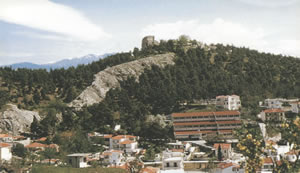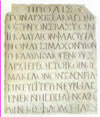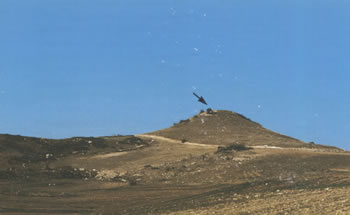AN OUTLINE OF THE HISTORY OF THE CITY
OF SERRES UNTIL ITS LIBERATION
 |
| The ancient name of the city carved onto a column from the First Century B.C. (Serres, Archaelogical Museum). |
The city was known in ancient times under various names: Siris, Sirra, Sirae, Sarxa, Serra, Serrai, Serras, Sarra, Serra, Ser(r)e, Sirum, Seres, Fer(r)ai or Fe(r)rai, Serisk or Serski (slavonic), Siruz or Siroz (Turkish), Ceres, Saras, Serras, and most recently of all, Serres. As can be seen from the numerous variations above, the town's name has come down to us virtually unchanged from antiquity.
ANCIENT TIMES
The first historical reference to the noteworthy pre-Homeric city is in Herodotus, who calls the city "Siris of Paionii", and its inhabitants "Siriopaiones". The latter were also known as the Siropaiones, or the Sirinopaiones, Sires, Sirinoi, and finally Sirraioi, and were to appear on the historical scene in 513 B.C. Megabyzus, the Persian satrap of Thrace, campaigned against the inhabitants of Sirios in 496 B.C. on the order of Darius I of Persia. Beaten, their homeland handed over to the Thracian Odomantes, the Siropaiones were taken to Asia as slaves. The city was then renamed Odomantiki Siris.
 |
View of the Acropolis (Koulas Hill) from the West. |
Theopompos, the historian, describes the city as Thracian: "Sirra, a city of Thrace" (the national Sirraios), before it became part of the Kingdom of Philip II in 357 B.C. The Roman historian, Titus Livius writes that the Consul Emilius Paulus pitched camp in a plain near the capital of Odomantiki. Following its conquest by the Romans, Macedonia was divided into four sections, while the city lost its independence and was adjoined to the first of them, the capital of which was at Amphipolis.
 |
| A square construction made from re0used carved blocks of limestone at the foot of the central tower on the acropolis. |
Th exact location of the ancient city of Sirios has been narrowed down to the impressive, fortified acropolis on Koulas Hill. The earliest archaeological finds there date from the late Archaic Period, and include the remains of the foundations of an ancient structure on the brow of the hill, along with the square construction made from re-used carved blocks of limestone; and the Greek black-figure potsherds (from 530 B.C. or thereabouts) that litter the site.
 |
| An uninscribed Roman column (Serres, Archaiological Museum). |
But the ancient city was not confined to the fortified acropolis on the top of the hill; the main body of the city spread over the southern slopes of the hill, between two fast-moving mountain streams. The Roman cemetery covered the area between the north-western slopes of the hill - the location, today, of the city's Third High School - and stretched as far as the First High School and the opposite bank of the river, to what is now Serres Cathedral and Eleftherias Square. A number of inscribed Roman burial mounds have been uncovered in this area, along with other monuments from the same period, whether honourary, votive, or to commemorate elections.
 |
View of "Nisantasi" Hill in Metochi. |
These excavations have given us valuable historical information on the social, religious, and political organisation of the city. For example, we know that the now thoroughly urban city had its own government, as well as a municipality, councillors, market inspectors, an educational chief, a high priest, and a civic officer responsible for organising the city's games. During the reign of Septimius Severus (192 - 211 A.D.), the five cities of Odomantiki formed a federation - the "Pentapolis", under the leadership of the city of Siris.
Other settlements grew up during the Roman Period in the mountainous areas around the city of Sirios - areas recently reincorporated into the Municipality of Serres by the Kapodistria Bill - at (a) Eptamyloi (on the site now known as "Xerolakka"); (b) Oinousa (on the sites known now as "Ktimata" and "Vlaselnikos"); (c)Chionochori (the "Koula" and "Chania" areas); (d) Elaionas (at "Panagia", "Profitis Ilias", and "Chili Dousa"); (e) Vero (at "Agios Tryfonas"); and (f) Metochi (at the "Nisantasi" site).
Continue...